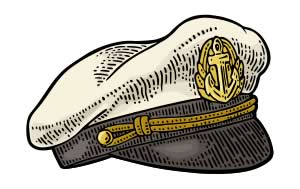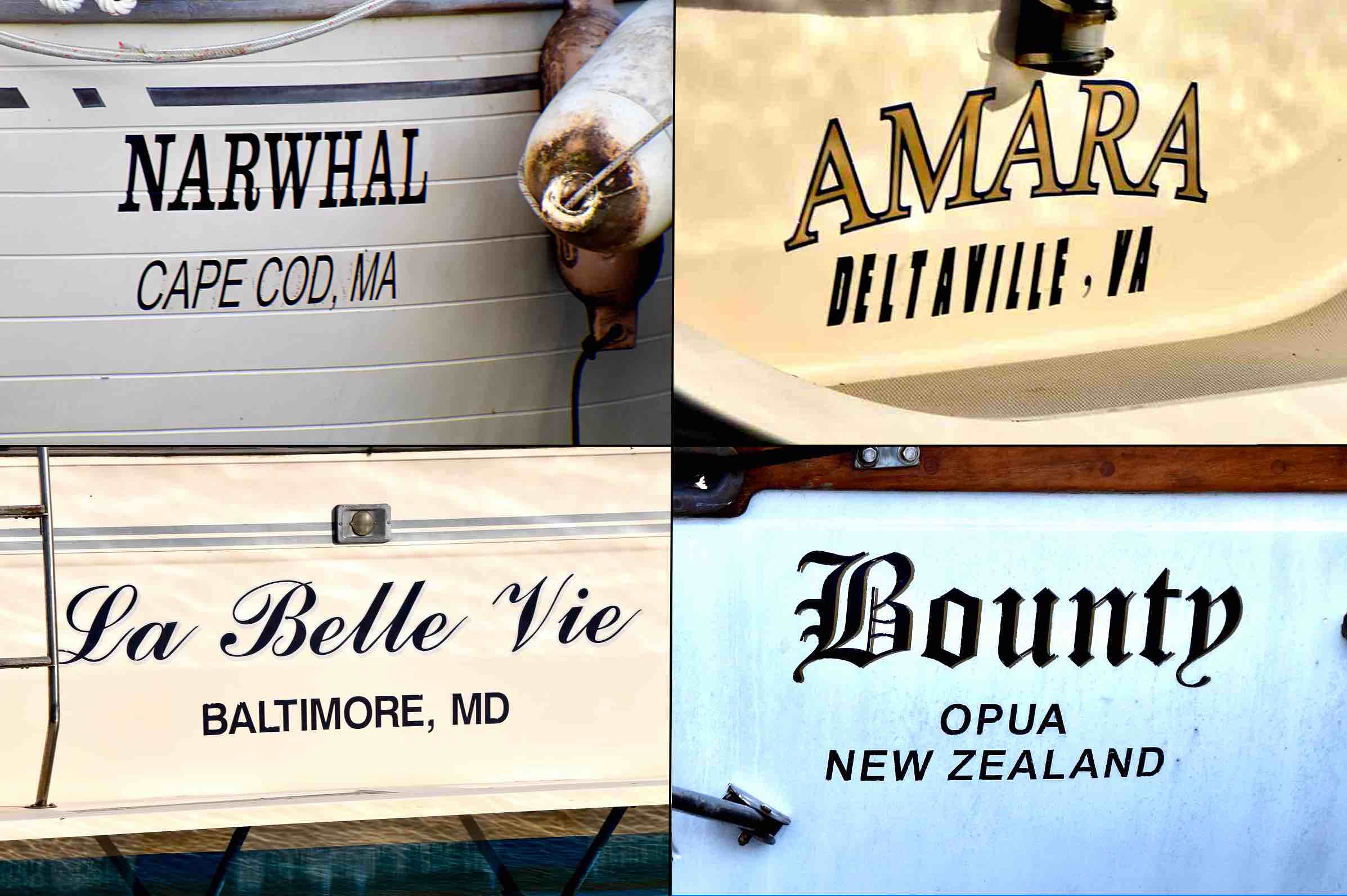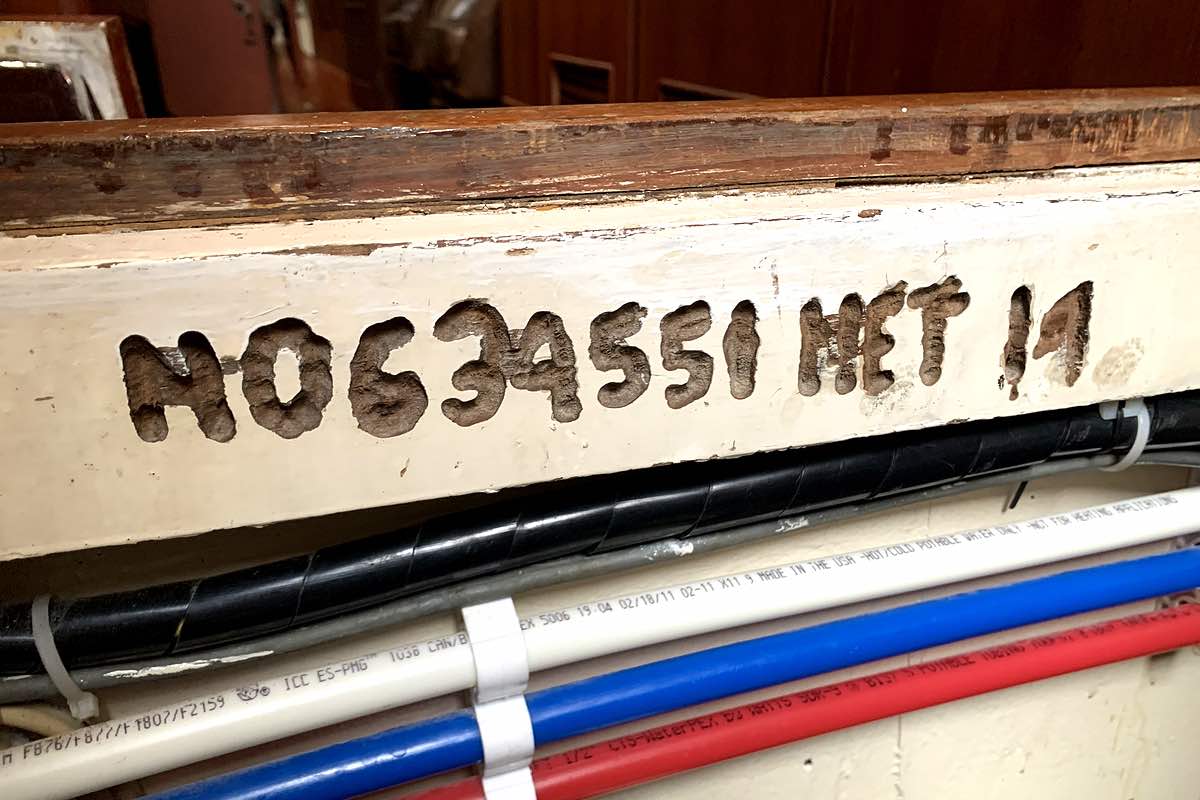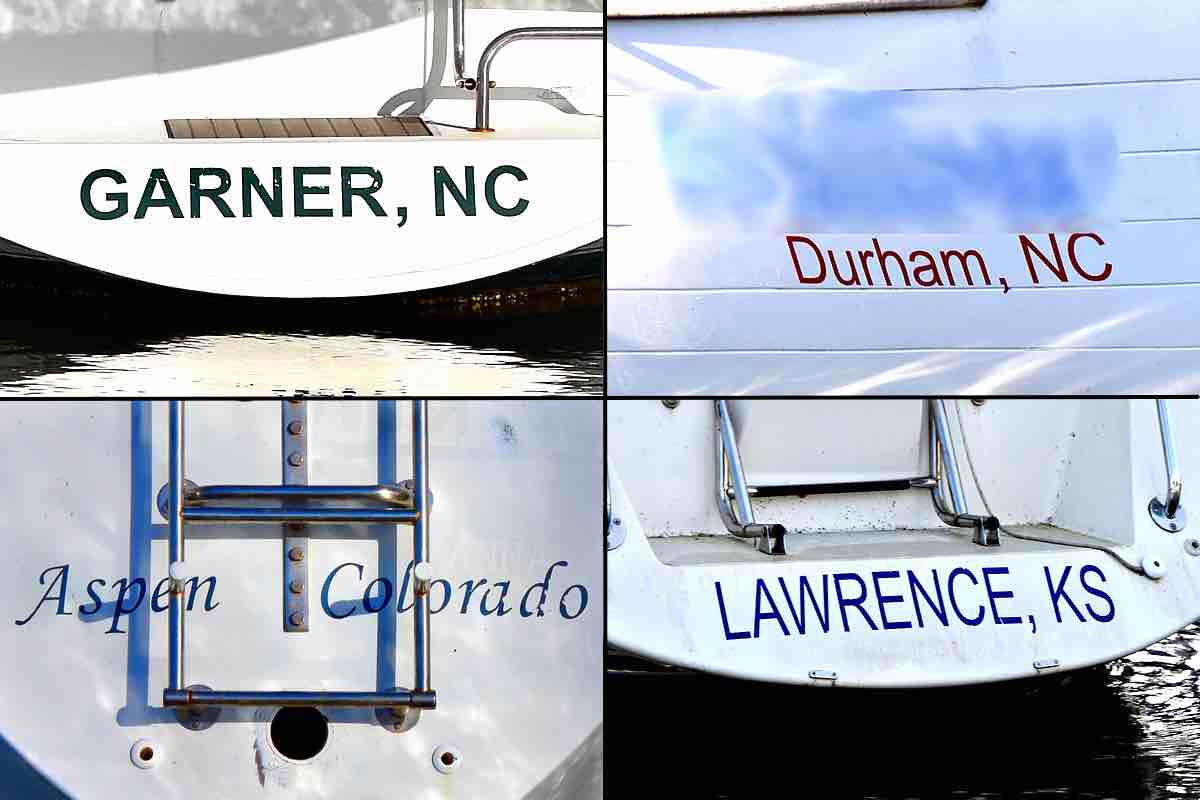It's Wednesday January 7, 2026

October 2021
Federal Code of Regulations, Title 46, Chapter 1, Subchapter G, Part 67Say what? This is a
diatribethoughtful discussion about vessel hailing ports displayed on the stern of boats. Before I pontificate opinion, perhaps a quick review of the applicable federal law would be helpful.Disclaimer: I have condensed the Federal Code of Regulation verbiage to facilitate understanding and easy reading. If after reading this, you have the inclination to peel the onion further, I encourage you to seek and read the actual regulations. Anyway…
Four hailing ports. Two are legit hailing ports. Two have names blurred out to protect those that may not yet know they are nautical miscreants.The law regarding hailing portsFederal law requires all documented vessels to designate and display a hailing port. Upon application for any Certificate of Documentation, the owner of the vessel must designate a hailing port to be marked upon the vessel.The hailing port must be a place in the United States included in the U.S. Department of Commerce’s Federal Information Processing Standards Publication 55DC. A hailing port cannot be another planet in a far far-away galaxy or a favorite crater on the moon.
Also, the hailing port must include the State, territory, or possession in which it is located.
Down the rabbit hole of name managementProcessors in the National Documentation Center query a United States Geodetic Service website to determine if a hailing port is valid. Names of places are managed by the United States Board on Geographic Names (BGN). The BGN is a Federal body created in 1890 and established in its present form by Public Law in 1947 to maintain uniform geographic name usage throughout the Federal Government.I am really sorry I wrote that. Apologies. But, now you know how names are managed. Anyway, back to hailing ports…
Back out of the rabbit holeThe Director, National Vessel Documentation Center has final authority to settle disputes as to the propriety of the hailing port designated.A Certificate of Documentation will only be deemed valid for operation of the vessel after the vessel is marked in accordance with requirements. Meaning, improper display of hailing port name invalidates the documentation certificate. Having the documentation paperwork is not enough. The documentation paperwork is only valid if the vessel is properly marked.
These are proper hailing ports. A proper hailing port has that ingredient that boats prefer – it’s on the water.Name and hailing port marking requirementsFor documented recreational vessels, the name and hailing port must be marked together on some clearly visible exterior part of the hull.For documented non-recreational vessels, the name must be marked on some clearly visible exterior part of the port and starboard bow, and the stern of the vessel. The hailing port of the vessel must be marked on some clearly visible exterior part of the stern of the vessel.
Although way cool, names on the booms do not satisfy marking requirements. The boom is not the hull.
The official number marking requirement for documented boatsThe official number of the vessel, preceded by the abbreviation “NO.” must be marked in block-type Arabic numerals not less than three inches in height on some clearly visible interior structural part of the hull. The number must be permanently affixed to the vessel so that alteration, removal, or replacement would be obvious.This ain’t pretty, but these numbers (in an engine room) are indeed “permanently affixed to the vessel so that alteration, removal, or replacement would be obvious.”I see many boats with the official number displayed on a salon bulkhead. Technically, this practice invalidates the certificate of documentation and even might result in a fine if boarded by authorities. If the vessel is being sold, a surveyor (in a bad mood) could find the vessel documentation invalid/none if the vessel is improperly marked. From the lenders or insurers perspective, invalid documentation could jeopardize the sale.
Now The Opinion/RantThe hailing port is for the vessel. NOT THE OWNER.Hailing ports are intended to identify the current operational port of the vessel. If you are from landlocked inland Caryville, but your boat is from Beaufort, the hailing port on your boat should be Beaufort. It’s nice that you are proud to be a Caryville resident, but there are better ways to display that.
An embroidered cardigan could allow you to display your Caryville pride.Also, the authorities do not care where you grew up or where you spent the majority of your adult life. (Schwenksville, Pennsylvania is never going to be my boat’s hailing port.) Simply put, a transom is not a billboard for displaying the location of the owner’s residence.
These may be city names. They are written on the stern. They are NOT hailing ports.Bottom line: The nautical authorities want to look at the vessel and know where it operates from. Period. If the vessel is moored in Whortonsville, the hailing port on the stern should read Whortonsville. Oriental is Oriental. New Bern is New Bern.
FurthermoreIf a vessel is not documented but only registered, vessel name and hailing port marking requirements are legally wide open. But, the above opinion still applies. And boat etiquette still matters.Sure, even if your hailing port says “Caryville” folks will still be nice to you at the marina. But, behind your back, there may be knowing snickers.
End of rant.
Next month is flag etiquette. Overwhelming anticipation I am sure. Can you wait?
Fair Winds,
Captain John RahmRelated Links• Death, Taxes, and Registration
• To Document Or Not
 Captain's Blog on TownDock.net is all about making your time on the water enjoyable. Captain John Rahm teaches sailing and boat handling at Third Wave Sailing. Captain's Blog on TownDock.net is all about making your time on the water enjoyable. Captain John Rahm teaches sailing and boat handling at Third Wave Sailing. |




